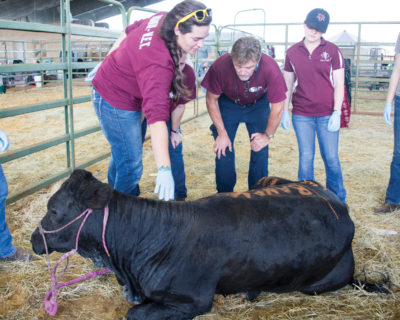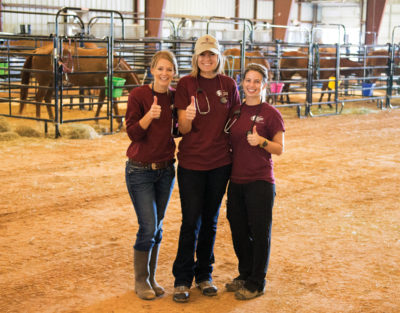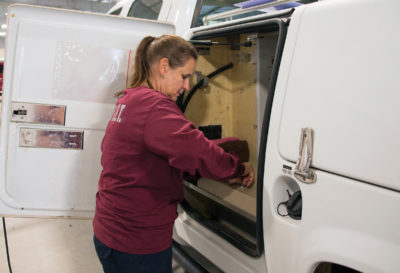Educating in an Emergency
The Texas A&M Veterinary Emergency Team serves the state through response, but also through its outreach efforts, dedicating a portion of its resources to traveling across Texas to help communities develop their own disaster preparedness plans.
Story by Chantal Cough-Schulze
Every month, the Texas A&M College of Veterinary Medicine & Biomedical Sciences’ (CVM) Veterinary Emergency Team (VET) gathers to learn and train. The team needs to be prepared—at any given moment they could deploy, which requires members to do anything from decontaminating animals near a nuclear facility to treating a horse injured in an overturned trailer.

“We’re an all-hazards team. We train for the spectrum, from wildfires to chemical plant explosions to infectious diseases,” said Dr. Wesley T. Bissett, VET director and associate professor of emergency management.
Created in 2009, the Texas A&M Veterinary Emergency Team is the nation’s largest and most sophisticated veterinary medical response team, providing statewide veterinary support. Equipped with a 15-vehicle fleet, the almost 100-member team responds to disasters and trains veterinary students to do the same; members on the educational staff and students also work with communities in advance of disasters.
Everywhere the team goes, they encounter unique challenges.
“What we deal with in College Station is very different than what the Panhandle deals with, or Orange, Texas, or the Rio Grande Valley,” Bissett said.
In the Panhandle, the issues the VET assists with are affected by the sheer size of the animal population.
Texas raises a lot of cattle—there are more cattle in Texas than there are people in Alabama, Arkansas, and Mississippi combined—and a large percentage of the nation’s cattle are fed in the Texas Panhandle.
When the cattle population is combined with the major swine operations in the Panhandle, the risks change. The sheer volume of animals, combined with such factors as global travel, provides the potential for infectious diseases to cause major problems, according to Bissett.
“The cattle are coming from all over the country. When you’ve got thousands of animals in close proximity to each other, the potential for the introduction of disease is pretty significant,” he said.

In addition to infectious diseases, there are three other major disasters that communities and livestock face in the Panhandle: wildfires, tornadoes, and winter weather. In late 2015, Winter Storm Goliath descended on dairy farms throughout West Texas, killing 30,000 head of dairy cattle. Across Texas this past summer, there were more than 890 wildfires.
“In the Panhandle, there are far fewer houses. Typically speaking, fewer houses means more animals in harm’s way. That’s a very unique challenge. A lightning strike or a downed power line—and then a wildfire starts,” Bissett said. “Wildfires move incredibly fast, and they’re incredibly destructive. We’ve been on a lot of different deployments, but wildfires are still one of the most challenging issues we face.”
To help address challenges like those seen in the Panhandle, the VET helps communities develop local emergency management plans and regional resources. In the communities with which the VET works, the VET brings together local firefighters, law enforcement, private veterinarians, and other animal professionals.
“The community defines the problem they want us to solve—an animal-related problem revolving around a disaster—and we solve it jointly,” Bissett said. “We do our homework on the community, we understand what the numbers are, and we figure out how to use their resources to solve the problem.”
Because of the scope of some disasters, the VET often has to coordinate with different organizations and both county and state governments from across Texas.
“We have to understand that what may solve our problem may create a problem elsewhere. We have to come up with solutions that are mutually beneficial,” Bissett said.

Understanding the nuances of disaster response isn’t just beneficial for affected communities; it’s also a valuable learning experience for veterinary students.
Fourth-year veterinary students are required to do a rotation with the VET in the nation’s only mandatory clinical educational experience in veterinary emergency response. During the rotation, five to seven students work with the VET each week, training and deploying with the VET wherever they go.
“When we go to the Panhandle, we go and stay,” Bissett said. “We’ll work all week, come home on Friday, switch students, and drive back.”
Wherever the VET goes, whether for developing plans or responding to a disaster, students are expected to participate. When the students work with the communities, they have to conduct themselves professionally, analyze the problems, and clearly communicate solutions.
The situations that veterinary students learn about are as diverse as the VET’s deployments. One emergency plan the VET has worked on is with the Pantex Plant, a nuclear weapons facility in Carson County. More than 6,000 people live in Carson County, along with more than 20,000 cattle.
“The operation at the Pantex Plant requires special plans for how to deal with the animal component if they have had an accident. It’s a fascinating problem set for our students to solve,” Bissett said.
Even though the training focuses on emergency management, the work is relevant to all veterinary students.
“Whether students are going into livestock management or becoming practice owners, the VET’s approaches apply,” Bissett said. “It’s all about problem solving and critical thinking.”
The VET rotation also gives students the opportunity to get to know other regions of Texas, along with all of their unique environments, emergencies, and people.
“We get our students out of College Station and into the far reaches of Texas. Our students get exposed to a broad range of environments and see what’s out there, meet the people, understand them, and understand what their problems are. We get to open students’ eyes to a lot of things.”

As the VET works to expand its impact, more students and communities will benefit from the team’s work in the future. Soon, the VET will be sending a field service vehicle to West Texas A&M University, where longtime VET partners Dr. Dan Posey and Dr. Dee Griffin will use it to support veterinary needs in the Panhandle; that unit was made possible by a donation from the Texas Equine Veterinary Association (TEVA).
“The vehicle is a truck with a veterinary box on it and will be outfitted with our cache of pharmaceuticals for both large and small animals,” Bissett said. “We’ll manage the whole logistics side of it. They’ll use it for delivering veterinary medical care, for their recruiting trips, and for working on school animals.”
The VET’s work, from their field service vehicle support to their disaster response and community collaboration, has far-reaching impacts.
But the benefits aren’t just economic. Helping communities prepare for wildfires, tornadoes, and disease outbreaks like those seen in the Panhandle—and teaching a new generation of veterinary students to do the same—has important psychological impacts, as well.
“Whenever we help a community, they’re better able to serve their citizens and their animals,” Bissett said. “The reality is, and I don’t care what species you’re talking about, they all matter. A herd of cattle is not just a financial investment; it is an emotional investment, a historical investment. There is a relationship there that is much more than financial. It is a family’s, and a community’s, hope for the future.”
###
Note: This story originally appeared in the 2019 Spring edition of CVM Today.
For more information about the Texas A&M College of Veterinary Medicine & Biomedical Sciences, please visit our website at vetmed.tamu.edu or join us on Facebook, Instagram, and Twitter.
Contact Information: Jennifer Gauntt, Interim Director of Communications, Media & Public Relations, Texas A&M College of Veterinary Medicine & Biomedical Science; jgauntt@cvm.tamu.edu; 979-862-4216


